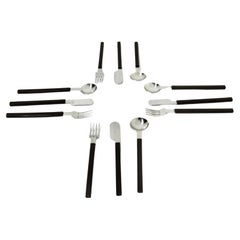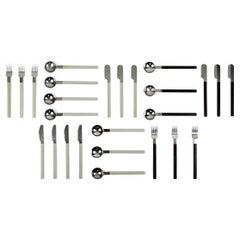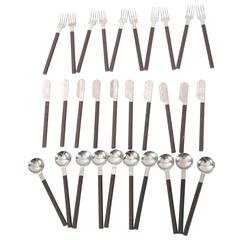Air France Concorde Cutlery
Vintage 1970s French Mid-Century Modern Serving Tables
Metal
Mid-20th Century French Mid-Century Modern Tableware
Stainless Steel
Recent Sales
Vintage 1960s French Mid-Century Modern Tableware
Stainless Steel
People Also Browsed
2010s American Mid-Century Modern Wall Lights and Sconces
Brass, Bronze, Enamel, Nickel
Vintage 1950s Danish Scandinavian Modern Tableware
Stainless Steel
21st Century and Contemporary French Modern Coffee and Cocktail Tables
Stainless Steel
Vintage 1960s Danish Mid-Century Modern Tableware
Stainless Steel
Vintage 1950s Tableware
Metal
Raymond Loewy for sale on 1stDibs
For those in the know, French-born American industrial designer Raymond Loewy is the “father of streamlining.” He is widely recognized as a pioneer of industrial design consulting — a creative powerhouse who took aim at cluttered designs and simplified them. Loewy left his mark on everything from toothbrushes to trashcans to spacecraft interiors. He designed cars, worked in illustration, and crafted comely dressers and other furniture.
Loewy was born in Paris, France. At age 15, he designed a model airplane that was powered by rubber bands. It won the James Gordon Bennett Cup of 1908. Loewy patented the model kit for this plane by the following year and saw brisk sales. With his savings, Loewy was able to study at the University of Paris and then at Ecole de Lanneau, where he earned an engineering degree in 1918.
Loewy moved to New York City in 1919 and found work as a window designer for the department stores Macy's, Wanamaker's and Saks and as a fashion illustrator for Vogue and Harper's Bazaar. Loewy’s big break in industrial design came in 1929 when he altered the Gestetner duplicating machine — removing jutting parts and encasing the moving works in an understated cover. It caused a sensation within the industry — and companies began to call on him.
Loewy designed packaging for Coca-Cola and revised the look of Lucky cigarettes. The “Loewy Look,” which referred to the designer’s efforts to strip a product of any unnecessary detail and streamline its appearance, began to characterize hundreds of products.
Loewy found clients in a dizzying number of companies. He did everything from retooling logos to redesigning products. His 1934 Sears Coldspot refrigerator was a sleek innovation that broke sales records. His Pennsylvania Railroad locomotive resembled a speeding bullet and was the darling of the 1939 World’s Fair. Loewy even reworked shapes for snacks at Nabisco. By the time World War II gathered steam, Raymond Loewy Associates — the industrial design firm he founded — had been operating in a number of American cities. When Time magazine featured him on the cover in October 1949 — Loewy was not shy about publicity — his profile soared.
Loewy worked with Studebaker for decades. The success of their 1953 Starliner coupe was due to his revolutionary design, while their 1963 futuristic, fiberglass-bodied Avanti, which came with advanced safety features and materialized at a time when the company was experiencing financial hardship, was his crowning achievement for the maker.
Returning to his roots in aviation, Loewy worked for NASA from 1967 to 1973 on the interior design of the Skylab space station. He was also involved in the interior designs of the Concorde supersonic jet and Air Force One. Loewy delighted in creating furniture and collaborated with manufacturers such as Mengel Furniture, Rosenthal and Doubinsky Frères. In the 1970s, Loewy and his wife shuttered their businesses and retired in France.
On 1stDibs, find vintage Raymond Loewy cabinets, serveware, seating and more.
A Close Look at Mid-century-modern Furniture
Organically shaped, clean-lined and elegantly simple are three terms that well describe vintage mid-century modern furniture. The style, which emerged primarily in the years following World War II, is characterized by pieces that were conceived and made in an energetic, optimistic spirit by creators who believed that good design was an essential part of good living.
ORIGINS OF MID-CENTURY MODERN FURNITURE DESIGN
- Emerged during the mid-20th century
- Informed by European modernism, Bauhaus, International style, Scandinavian modernism and Frank Lloyd Wright’s architecture
- A heyday of innovation in postwar America
- Experimentation with new ideas, new materials and new forms flourished in Scandinavia, Italy, the former Czechoslovakia and elsewhere in Europe
CHARACTERISTICS OF MID-CENTURY MODERN FURNITURE DESIGN
- Simplicity, organic forms, clean lines
- A blend of neutral and bold Pop art colors
- Use of natural and man-made materials — alluring woods such as teak, rosewood and oak; steel, fiberglass and molded plywood
- Light-filled spaces with colorful upholstery
- Glass walls and an emphasis on the outdoors
- Promotion of functionality
MID-CENTURY MODERN FURNITURE DESIGNERS TO KNOW
- Charles and Ray Eames
- Eero Saarinen
- Milo Baughman
- Florence Knoll
- Harry Bertoia
- Isamu Noguchi
- George Nelson
- Danish modernists Hans Wegner and Arne Jacobsen, whose emphasis on natural materials and craftsmanship influenced American designers and vice versa
ICONIC MID-CENTURY MODERN FURNITURE DESIGNS
- Eames lounge chair
- Nelson daybed
- Florence Knoll sofa
- Egg chair
- Womb chair
- Noguchi coffee table
- Barcelona chair
VINTAGE MID-CENTURY MODERN FURNITURE ON 1STDIBS
The mid-century modern era saw leagues of postwar American architects and designers animated by new ideas and new technology. The lean, functionalist International-style architecture of Le Corbusier and Bauhaus eminences Ludwig Mies van der Rohe and Walter Gropius had been promoted in the United States during the 1930s by Philip Johnson and others. New building techniques, such as “post-and-beam” construction, allowed the International-style schemes to be realized on a small scale in open-plan houses with long walls of glass.
Materials developed for wartime use became available for domestic goods and were incorporated into mid-century modern furniture designs. Charles and Ray Eames and Eero Saarinen, who had experimented extensively with molded plywood, eagerly embraced fiberglass for pieces such as the La Chaise and the Womb chair, respectively.
Architect, writer and designer George Nelson created with his team shades for the Bubble lamp using a new translucent polymer skin and, as design director at Herman Miller, recruited the Eameses, Alexander Girard and others for projects at the legendary Michigan furniture manufacturer.
Harry Bertoia and Isamu Noguchi devised chairs and tables built of wire mesh and wire struts. Materials were repurposed too: The Danish-born designer Jens Risom created a line of chairs using surplus parachute straps for webbed seats and backrests.
The Risom lounge chair was among the first pieces of furniture commissioned and produced by celebrated manufacturer Knoll, a chief influencer in the rise of modern design in the United States, thanks to the work of Florence Knoll, the pioneering architect and designer who made the firm a leader in its field. The seating that Knoll created for office spaces — as well as pieces designed by Florence initially for commercial clients — soon became desirable for the home.
As the demand for casual, uncluttered furnishings grew, more mid-century furniture designers caught the spirit.
Classically oriented creators such as Edward Wormley, house designer for Dunbar Inc., offered such pieces as the sinuous Listen to Me chaise; the British expatriate T.H. Robsjohn-Gibbings switched gears, creating items such as the tiered, biomorphic Mesa table. There were Young Turks such as Paul McCobb, who designed holistic groups of sleek, blond wood furniture, and Milo Baughman, who espoused a West Coast aesthetic in minimalist teak dining tables and lushly upholstered chairs and sofas with angular steel frames.
Generations turn over, and mid-century modern remains arguably the most popular style going. As the collection of vintage mid-century modern chairs, dressers, coffee tables and other furniture for the living room, dining room, bedroom and elsewhere on 1stDibs demonstrates, this period saw one of the most delightful and dramatic flowerings of creativity in design history.
- What did Raymond Loewy design?1 Answer1stDibs ExpertFebruary 22, 2021Raymond Loewy is known as the father of industrial design. While he has designed razors, railroad terminals and more, Loewy is well known for notable logos such as the Lucky Strike cigarette packet and Coke bottle.


